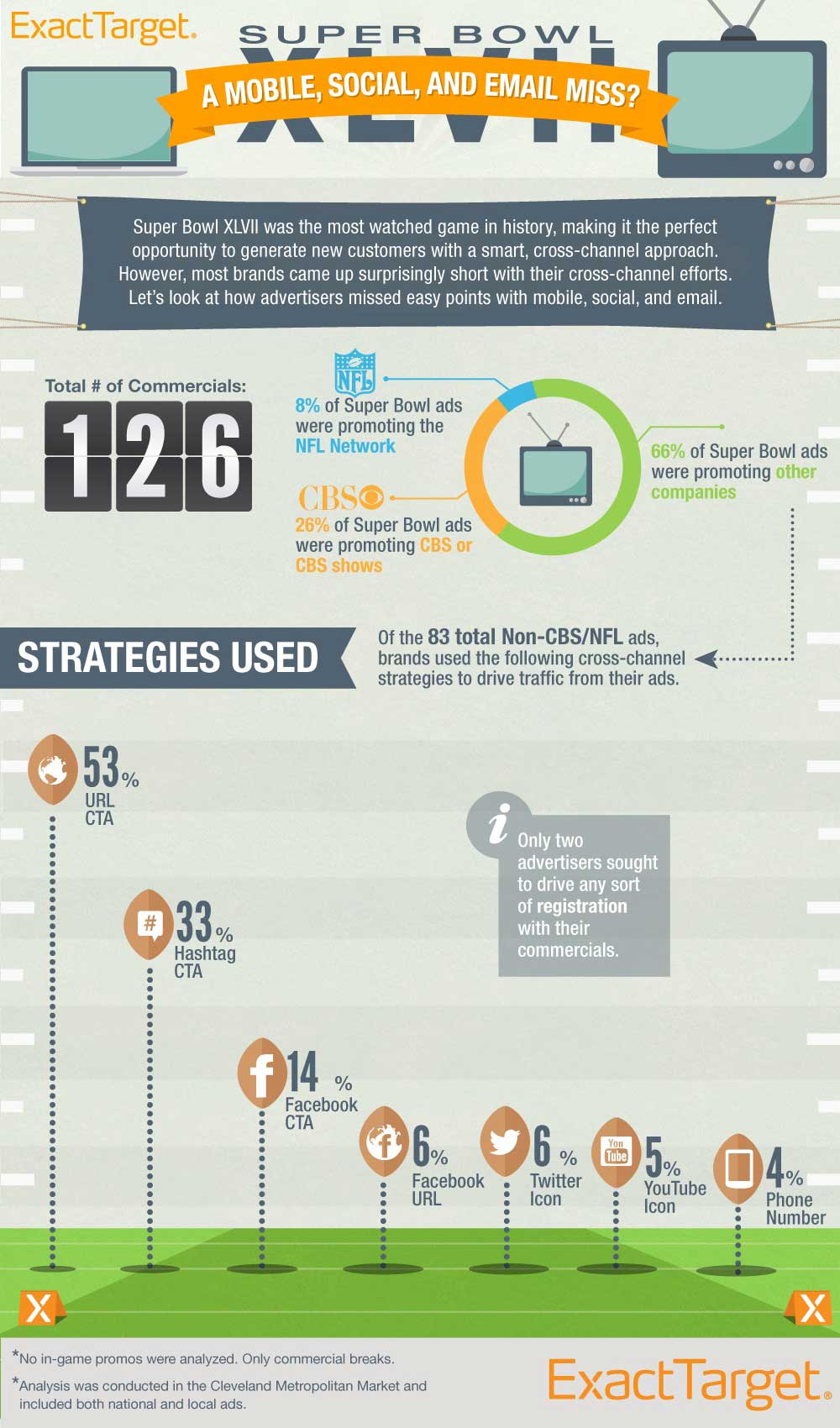With Super Bowl XLVII now in the books, we all know what time it is. It's time to start thinking about the 2014 Super Bowl, when my Cleveland Browns will rise like a phoenix from the ashes and claim their first Lombardi Trophy in what will undoubtedly be described as the greatest franchise turnaround in the history of sport.
This, of course, will not happen. But a boy can dream...
I can also hope against hope that the advertisers that underwrite the 48th Super Bowl will learn some pretty big lessons from this year's. I know I sure did. And the lessons learned aren't just applicable to brands with big advertising budgets; they are applicable to any marketer looking to get more ROI from marketing investments.
But before I get to those lessons, let me share how I discovered them.
Instead of watching the Super Bowl in real-time like a normal human being, I fired up the DVR and logged each and every commercial—national and local to my market—that ran from 6 PM EST through the commercial break after the final whistle. I then went back and logged each and every call to action involving the Web, mobile channels, social media, and telephone.
The findings were a true head-shaker, and most are compiled in the infographic at the end of this article. The rest you can find in my recent blog rant, "Punt, Pass & Kick: Email, Mobile & Social Misses at Super Bowl XLVII."
Now that I've had some time to ponder what the brands near total failure to engage viewers beyond the TV screen means, I'm able to distill my thoughts into these seven lessons for Super Bowl XVLIII's advertisers—and everybody else.
Lesson No. 1: Big advertising bets demand big calls to action
Whether you're Mercedes-Benz spending millions on a Super Bowl teaser campaign for a new car or Donny's Car Wash contemplating a big direct mail campaign... advertising costs too much these days for you to be satisfied with just "branding." You must include some meaningful call to action to ensure that you derive some direct and immediate benefit from your spend.
Mercedes-Benz advertised a car that doesn't come out until September 2013. The company spent beaucoup dollars to get Willem Defoe to star, and it licensed "Sympathy for the Devil" from The Rolling Stones as the soundtrack. And what was the ad's call to action? A muted Facebook page URL in the closing seconds of the spot. A spot they had been teasing for weeks with other ads. What a huge miss. The ad could have driven people to register to learn more. To win the first one off the assembly line. To share why they need that car.
For such a big launch, it lacked the big call to action that the advertising spend warranted. As a result, Mercedes created some product awareness but no ability to reach back out to interested consumers. What a miss.
Lesson No. 2: Advertising should build your proprietary audiences
Mercedes-Benz was not alone in failing to use its Super Bowl ad time to build audiences via Web, mobile, and social channels. In fact, only one advertiser did so in any overt way during their commercial: Oreo.
A lot of marketing minds have rightfully praised Oreo for its very smart, very quick, real-time marketing response to the blackout. Who knew that a picture of a cookie in the dark could generate over 16K retweets, 21K likes, and 7K shares? But Oreo's smartest move was using its "Whisper Fight" commercial to drive Instagram followers up from 2,200 pre-commercials to over 59,000 as of this writing. It not only created new audiences for itself that's not beholden to pay-to-play advertising fees but also started a flood of engagement with loyal brand fans.
If you haven't seen it, go check out Oreo's Instagram page now. Followers are submitting photos so Oreo can #cremethis or #cookiethis—i.e., reproduce the photos out of Oreo crème filling or cookies, or both. The resulting photos are then being amplified by Oreo on Instagram, Facebook, and Twitter—and its subscribers, fans, and followers are amplifying them, as well, to their personal networks.
I could go on and on about what Oreo has done here, but the lesson for every marketer is summed up with a simple acronym inspired by the greatest Swedish supergroup the world has ever known: ABBA—"Always Be Building Audiences."
Use your paid media to build your owned audiences so you can have your loyalists on "speed-dial" at a lower cost to engage.
Lesson No. 3: Provide a reason to engage
As our infographic lays out, off all the Super Bowl XLVII commercials, only...
- 53% included URLs.
- 33% incorporated hashtags.
- 6% included a Facebook page URL.
- 6% included a Twitter icon.
- 5% included a YouTube icon.
When I reviewed each commercial, those numbers became even less impressive, because all too often they were merely social icons slapped onto the end of each commercial.
Icons alone do not provide a reason to engage. Oreo gave people a reason to engage on Instagram—asking brand fans to decide which was better, the crème filling or the cookie. But few other commercials shared any rationale at all.
What's your rationale? Why do you want your consumers to interact with you via social media? If you can't give them a reason, why should they even try?
And, let's be honest, Facebook and Twitter icons are window dressing. They aren't meaningful calls to action.
Lesson No. 4: Let your call to action resonate
If I had to guess, I'd say that the average amount of time devoted to Web, mobile, and social calls to action in each Super Bowl commercial was about two seconds. And that's being generous. How can any consumer scribble down your URL if you don't have it on screen for more than two seconds?
What's clear from this year's Super Bowl ads is that the creative brand folks and their agencies are still running roughshod over their digital counterparts. Web, mobile, and social engagement is an afterthought—an annoying bit of punctuation; they'd rather be devoting efforts to their creative execution.
It's time that interactive, email, mobile, and social media marketers rise up and demand that their needs to ABBA drive the creative. If the goal isn't to just sell but also to build proprietary audiences, then the calls to action need to be more creative and they need to appear on screen longer.
The lesson for all marketers: go audit your calls to action. Are you giving them time to breathe, or are you shoehorning them into a space that would fail to inspire any reasonable consumer to take action? It may be time to get your priorities straight.
Lesson No. 5: Eat, sleep, drink mobile
I'm still a bit stunned that at a time when the Mobile Marketing Association estimates that 91% of viewers used their mobile devices during the commercials, overt mobile calls to action were almost completely absent from the Super Bowl. As I noted in my blog post on the subject, only 1%—one single, solitary ad—included an SMS call to action, and only one ad encouraged viewers to download a mobile app.
Are you kidding me? At a time when over 90% of the US adult population has cell phones and over 50% of those are smartphones, what were Super Bowl advertisers thinking?
There are so many ways to engage mobile users—SMS, mobile websites, email, proprietary apps, social media apps—the list literally goes on and on. And, guess what, it's only going to expand.
So, regardless of your marketing budget, you had better be looking at how and where you interact with customers and you'd better be testing new mobile ways of engagement. Mobile gives you the opportunity to take greater advantage of location and real-time events, and that's good news for any brand.
Lesson No. 6: hashtags are agnostic
Another marketing publication did a similar analysis to mine and concluded that Twitter "won the Super Bowl" because the combined use of Twitter icons and hashtags dwarfed the mentions of Facebook. The problem with that analysis is that it considers hashtags to be the sole property of Twitter. They are not.
Hashtags have made the leap from Twitter to Facebook to Instagram to Pinterest to LinkedIn to Google+ and to blogs.
In that sense, the 33% of Super Bowl advertisers that incorporated hashtags into their commercials were smart; they were seeking to spark social conversation wherever it may occur. The problem, however, is that hashtags alone are not calls to action. They are unique identifiers. And what most brands that use them in commercials do... is post them and pray.
If you truly want to have a chance of sparking a lasting conversation, you need to give viewers a reason to engage—like Oreo's #cremethis and #cookiethis.
Imagine if Dodge had punctuated its impressive "God Made a Farmer" ad with a hashtag like #ThankAFarmer and encouraged viewers to thank the few remaining small, family farmers who provide such a vital service to the world. I suspect that simple inclusion—in a 120 second commercial, mind you—would still be driving meaningful engagement and conversation today.
Sometimes, it's just that added bit of energy and explanation that can drive your marketing efforts to new heights.
Lesson No. 7: Fish where the fish are (and the fishermen aren't)
In my mind, one of the clear winners of the Super Bowl advertising wars for the second year running didn't actually run an ad during the Super Bowl. It was Papa John's, which sponsored the coin toss—only the most watched coin toss in the world.
I've blogged about the coin-toss campaign before: In a nutshell, Papa John's sponsors the coin toss and gives everyone in America a chance to make the call—heads or tails. If you call it correctly, you win a free pizza and you're notified via email the day after the Super Bowl.
I'm now two-for-two in this promotion (always bet on heads), which makes my kids exceedingly happy. But the real happiness has to be at Papa John's headquarters, where they continue to pay less than Super Bowl premium advertising prices—because they advertise this campaign before the Super Bowl—and they continue to not only drive game-day sales but also grow their proprietary, permission-based email database each time a new person registers.
Papa John's gets ABBA. Like Oreo, it understands that the job of great marketing isn't just to sell in the moment but for the days, weeks, and months after the ads have faded from memory. And Papa John's also gets that being creative sometimes means creating marketing moments out of nothing.
The coin toss is that moment for Papa John's. What's yours? What might it be?
* * *
You don't need a Super Bowl budget to do Super Bowl-worthy things with your marketing dollars. And as we saw on Sunday, even the biggest brands in the world are leaving opportunities on the table.
As mass media, digital media, and social media fragment, our jobs as marketers isn't just to be visually creative—it is to be strategically creative with our budgets, our calls to action, and our various digital properties.
So don't settle for what others are doing; instead, ask yourself how you can get more from what you already do. That's an effort worthy of being called "Super."





